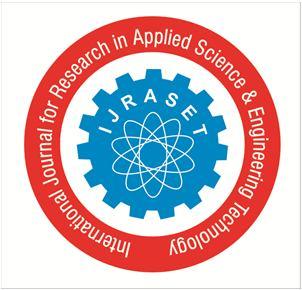
3 minute read
International Journal for Research in Applied Science & Engineering Technology (IJRASET)

ISSN: 2321-9653; IC Value: 45.98; SJ Impact Factor: 7.538
Advertisement
Volume 11 Issue IV Apr 2023- Available at www.ijraset.com
By developing this prototype, we have seen that the YOLOV4 model operates and recognises animals successfully. When we execute the YOLO V4 algorithm, it produces both right forecasts and delivers an exact distance. In the future we can gradually improve the model by adding an alert (buzzer) message that needs to be generated and should be sent to the driver or user.This suggested study has focussed on automated animal recognition with relation to Indian highways. Both the animal identification and range calculation is done by YOLOV4 technique. Even farther frameworks similar to YOLOX may be utilized for identification of many other species just after proper training and evaluation.
References
[1] Gupta, S., Chand, D., Kavati, I. (2020). Computer Vision based Animal Collision Avoidance Framework for Autonomous Vehicles. Retrieved 3 August 2022, from https://arxiv.org/abs/2012.10878
[2] Computer Vision based Animal Collision Avoidance Framework for Autonomous Vehicles
[3] Sato, D., Zanella, A., Costa, E. (2021). Computational classification of animals for a highway detection system. Brazilian Journal Of Veterinary Research And Animal Science, 58, e174951. doi: 10.11606/issn.1678-4456.bjvras.2021.174951
[4] M. Yoshioka, N. Suganuma, K. Yoneda, and M. Aldibaja, “Real-time object classification for autonomous vehicle using LIDAR,” in Proc. Int. Conf. Intell. Informat. Biomed. Sci. (ICIIBMS), Nov. 2017, pp. 210–211.
[5] J. Ciberlin, R. Grbic, N. Tesli c´, and M. Pilipovic´, “Object detection and object tracking in front of the vehicle using front view camera,” in Proc. Zooming Innov. Consum. Technol. Conf. (ZINC), May 2019, pp. 27–32.
[6] K. Pranav and J. Manikandan, “Design and evaluation of a realtime pedestrian detection system for autonomous vehicles,” in Proc. Zooming Innov. Consum. Technol. Conf. (ZINC), May 2020, pp. 155–159.
[7] H.-T. Tseng, C.-C. Hsieh, W.-T. Lin, and J.-T. Lin, “Deep reinforcement learning for collision avoidance of autonomous vehicle,” in Proc. IEEE Int. Conf. Consum. Electron. Taiwan (ICCE-Taiwan), Sep. 2020, pp. 2063–2068.
[8] Y. Fu, C. Li, F. R. Yu, T. H. Luan, and Y. Zhang, “A decision-making strategy for vehicle autonomous braking in emergency via deep reinforcement learning,” IEEE Trans. Veh. Technol., vol. 69, no. 6, pp. 5876–5888, Jun. 2020.
[9] G. Ozturk, R. Koker, O. ELDOgAN, and D. Karayel, “Recognition of vehicles, pedestrians and traffic signs using convolutional neural networks,” in Proc. 4th Int. Symp. Multidisciplinary Stud. Innov. Technol. (ISMSIT), Oct. 2020, pp. 1–8.
[10] W. Zhou, J. S. Berrio, S. Worrall, and E. Nebot, “Automated evaluation of semantic segmentation robustness for autonomous driving,” IEEE Trans. Intell. Transp. Syst., vol. 21, no. 5, pp. 1951–1963, May 2020.
[11] Y. G. Naresh, S. Little, and N. E. Oconnor, “A residual encoder decoder network for semantic segmentation in autonomous driving scenarios,” in Proc. 26th Eur. Signal Process. Conf. (EUSIPCO), Sep. 2018, pp. 1052–1056.
[12] M. Feng, S. Hu, G. Lee, and M. Ang, “Towards precise vehicle-free point cloud mapping: An on-vehicle system with deep vehicle detection and tracking,” in Proc. IEEE Int. Conf. Syst., Man, Cybern. (SMC), Oct. 2018, pp. 1288–1293
[13] Trnovszky, Tibor, et al. ”Animal recognition system based on convolutional neural network.” Advances in Electrical and Electronic Engineering 15.3 (2017):.517-525.
[14] Geethapriya. S, N. Duraimurugan, S.P. Chokkalingam “Real-Time Object Detection with Yolo” International Journal of Engineer- ing and Advanced Technology (IJEAT) ISSN: 2249 – 8958, Volume-8, Issue-3S, February 2019, Crossref,https://www.ijeat.org/wpcontent/uploads/papers/v8i3S/C11240283S19.pdf
[15] Reddy, B. Karthikeya, et al. ”Convolutional Network based Animal Recognition using YOLO and Darknet.” 2021 6th International Conference on Inventive Computation Technologies (ICICT)..IEEE,.2021.
[16] Manoharan, Samuel. ”Embedded Imaging System Based Behaviour Analysis of Dairy Cow.” Journal of Electronics 2, no. 02 (2020): 148-154.
[17] Kathuria “What’s new in YOLO v3?. A review of the YOLO v3 Object” Towards data science , April 23rd 2018.
[18] Manogna Mantripradaga “Digging deep into YOLO v3 – A handson guide” Towards data science, August 16th.
[19] Joseph Redmon “Darknet-53 Explained” Cornell University, April 2018, https://paperswithcode.com/method/darknet-53.
[20] Jiang, Peiyuan, et al. ”A Review of Yolo algorithm developments.” Procedia Computer Science 199 (2022):.1066-1073.
[21] Tan, Mengyu, et al. ”Animal Detection and Classification from Camera Trap Images Using Different Mainstream Object Detection Architectures.” Animals 12.15.(2022):.1976.
[22] Gomez, Alexander, Salazar, Augusto, Vargas, Francisco, To- wards Automatic Wild Animal Monitoring: Identification of Animal Species in Camera-trap Images using Very Deep Convolutional Neural Networks, Ecological Informatics(2017), doi: 10.1016/j.ecoinf.2017.07.004
[23] Felzenszwalb, Pedro F., et al. ”Object detection with discriminatively trained part-based models.” IEEE transactions on pattern analysis and machine intelligence 32.9 (2010):.1627-1645.
[24] Gao, Cui, Qiang Cai, and Shaofeng Ming. ”YOLOv4 object detection algorithm with efficient channel attention mechanism.” 2020 5th International Conference on Mechanical, Control and Computer Engineering (ICMCCE)..IEEE,.2020.
[25] Redmon, Joseph and Ali Farhadi. “YOLOv3: An Incremental Improvement.” ArXiv abs/1804.02767 (2018): n. pag.


